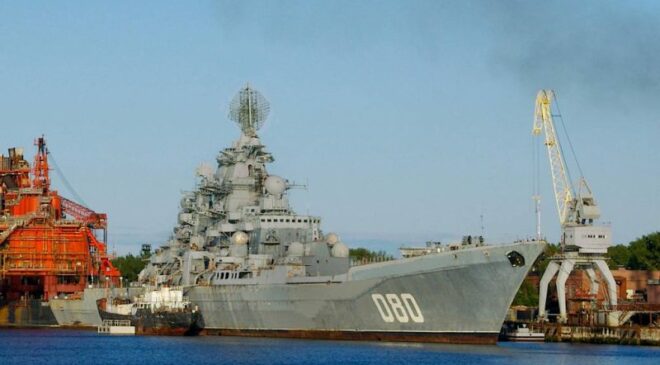After the loss of the Moskva, and pending the return to active service of the Russian Kirov-class nuclear cruiser Admiral Nakhimov after extensive modernization, the Russian Navy's cruiser fleet is limited to three ships: the Slava-class cruisers Marshal Ustinov and Varyag, sister ships of the Moskva, and the nuclear-powered cruiser Pyotr Veliky, an upgraded version of the Kirov class.
Entering service in 1998, the Veliky is today the most powerful combat surface unit in service with the Russian Navy and as such assumes the role of flagship of the powerful Northern Fleet. It was, so far, to enter the modernization phase once the Nakhimov returned.
However, it seems that the considerable credits that the modernization of her sister-ship will have cost, and perhaps the disastrous fate of the Moskva in the Black Sea, will have got the better of the future of the most imposing cruiser built since the Sixties.
Indeed, according to the Tass agency citing sources close to the Admiraltyhey, the next one Borei-A class nuclear ballistic missile submarine, whose construction will begin next year, will be named after Pyotr Veliky.
The ship should enter service in 2030, so this assumes that not only will the eponymous cruiser itself leave service on this date, but that it will not, as announced so far, be modernized.
In fact, it is likely that the ship should be relatively quickly withdrawn, while according to certain information, the crew of the Nakhimov which should soon join the active service, was made up partly from the manpower of the Veliky.

The Pyotr Veliky was until now the most modern Kirov, notably having a surveillance and detection chain modernized in 2009 with Top Pair and Top Plate radars, and increased firepower, with 20 anti-ship missiles P700 supersonic missiles (NATO code SS-N-19), 48 long-range 48N6 anti-aircraft missiles of the S-300FM system (NATO designation SA-N-20), 48 5V55RM anti-aircraft missiles of the S-300F system (NATO code SA-N-6), as well as 64 9M330 short-range anti-aircraft missiles of the 3K95 Kinzhal system (SA-N-9 for NATO, naval version of the TOR).
The ship also carries 1 twin-tube 130 mm AK-130 gun, 6 Kashtan CIWS systems, 10 533 mm torpedo tubes as well as RBU 1000 and 12000 anti-submarine rocket launchers.
252 meters long, it reaches a loaded displacement of 28.000 tons, that of 3 Arleigh Burke destroyers, and implements up to three Helix naval helicopters. However, despite this firepower, these exceptional measurements and its almost unlimited autonomy due to its nuclear propulsion, the ship suffers from several weaknesses.

75% of this article remains to read,
Subscribe to access it!
The Classic subscriptions provide access to
articles in their full version, and without advertising,
from 6,90 €.
Newsletter subscription
Register for the Meta-Defense Newsletter to receive the
latest fashion articles daily or weekly

